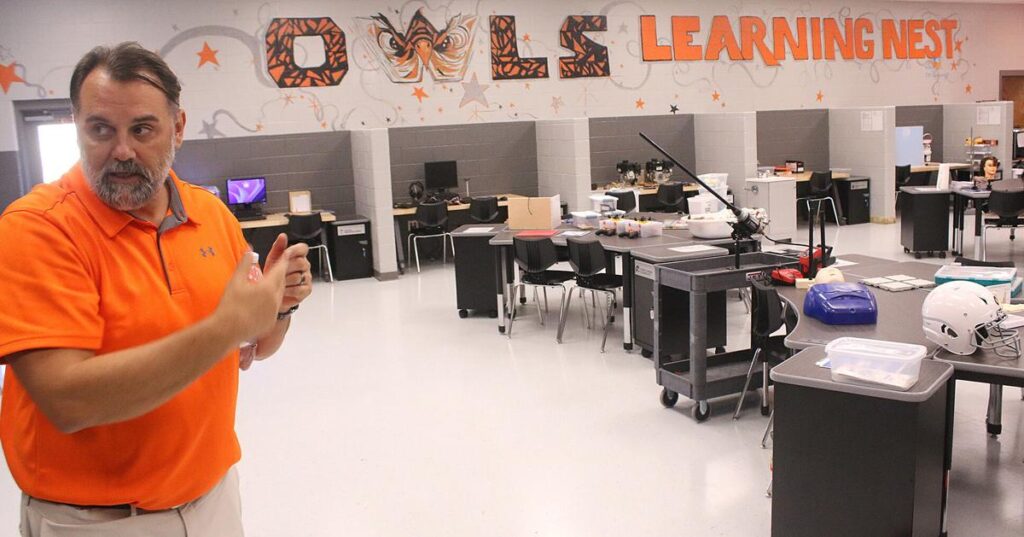Eighth-grade students get to study a plethora of fields through LaFollette Middle School’s new career and technical education lab.
“I wish I had this when I was in school,” said Missy Lambert, who teaches computer science and CTE at LMS.
There are stations for a variety of career fields, including structural engineering, cosmetology, dentistry, hospitality and tourism management and much more.
“Like in nursing, they actually get to draw blood from the arm with a butterfly needle, and then they suture the cuts on the leg,” Lambert said.
There are 32 different modules out for kids to explore, Lambert said.
“Criminalistics, I was in here the other day and kids were analyzing blood-pattern splatters,” said Stefan Piercy, LMS principal.
Most of the learning modules encompass 10 class periods, Piercy said.
“We’ve got small engine repair,” Piercy said. “You can’t tell me a kid in Campbell County that doesn’t like that.”
Culinary arts is the focus of another module, and Piercy recalled kids cooking scrambled eggs recently. Last Friday morning, kids whipped up protein balls.
“We’ve got welding basics,” Piercy said. “Learn how to weld. Over here, we’ve got veterinary medicine.”
At one station, kids work on a video game, Lambert said.
“It has a pre-installed video game, but then they have to go through and edit all the levels,” Lambert said. “They have to do the kill zones. They have to put a timer on it when the game’s over. So they are going through and editing the game.”
Virtual-reality headsets have 42 different careers installed, with activities as varied as changing the oil in a car to performing knee surgery, Lambert said.
“They climb,” Lambert said. “It actually looks like you’re climbing a ladder at a football stadium, like a bucket truck, to get up and change the lights. I can’t do that one. It makes me sick. But there’s truck driving. It’s crazy, and they love those.”
It is typically two students at each station, Lambert said.
“Some of these jobs in here, they’re not prevalent,” Piercy said. “Your mom and dads don’t do them. They don’t know about them. This is a great opportunity for our kids to discover a different path, not to mention all the problem solving. A lot of the work they do is in groups, so they have to figure out.”
And sometimes the kids teach each other, Piercy said.
“It leads to a lot of collaboration between someone else, trying to work through a problem,” Piercy said. “A lot of times, our kids nowadays can’t even have a face-to-face conversation, but if we give them a challenge together, that’s a huge step in the right direction. Plus it’s also a real-life experience. I know a lot of times, even in the regular classroom, we’re always looking for that real-life connection. This is real life.”
Kids can make their way through around six or seven modules in a semester, Lambert said.
“One thing I do like about it, these two might work together this time around, but the next 10 days, they might have a totally different partner,” Lambert said. “So I’ve seen kids that never even spoke to each other before, come together and work as a team.”
Students started working in the lab with the start of this school semester.
“They’ll learn from the module, but then they’ve got to work together to figure out some of the activities that they have to perform,” Lambert said.
About 30 eighth-grade students are working in the lab currently, but next semester, that number will go up to around 60 to 90 eighth-grade students.
“I have two class periods for CTE for eighth-graders, which, after talking to Traci [Chambers], we’re going to try to open it up maybe next year to seventh-grade because in one semester, you can’t get through all the modules,” Lambert said.
At each module, there is a specific curriculum plan that the students go through over the 10 class periods of that station.
“You can research careers all day long, but this is actually, you’re getting hands on to see whether it’s something you’re interested in or not,” Lambert said.
Students get to pick the first few stations that they will do, Lambert said.
“The kids absolutely love the activities,” Lambert said. “So like in flight and drone, they actually build their own drone, and then they learn all the mechanics of flying it. So I mean, it’s very, very hands-on, and they love that stuff.”
After the first few modules, students take a survey, with results dictating which module the student will do next.
“I have some kids that, over there, they have to put up a shelf, and then they have to patch the drywall and repaint it,” Lambert said. “And I was telling them. I said, ‘I didn’t even do that until I was probably in my 20s with my own home.’ So I mean, I didn’t know anything about doing stuff like that. So they’ve got to do a lot of things that they never would have gotten to do.”
And then at times, some students just take some modules at random.
“Just spin the wheel, do it randomly, and then that’s when, some kids got in, like I said, we’re doing the sink, and they were like, ‘Wow, I just re-did the drain on the sink.’ So they can find things that they didn’t know that they were even interested in,” Lambert said.
That way of picking modules provides a variety, Lambert said.
“It’s a bunch of doors,” Piercy said. “Which one am I going to open? Where do I want to go? What’s my path?”

